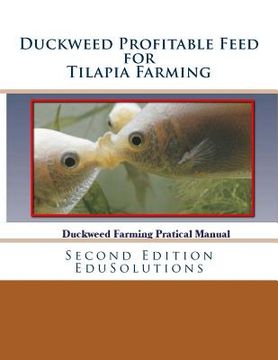Duckweed Profitable Feed for Tilapia Farming: A Practical Manual to Tilapia Feeding (en Inglés)
Reseña del libro "Duckweed Profitable Feed for Tilapia Farming: A Practical Manual to Tilapia Feeding (en Inglés)"
Tilapia Feed - Duckweed is a tiny aquatic plant covering stagnant water bodies; it's seen in channels and waterways in semi-tropical and tropical climates in most countries. The green, three rounds fronds plant, or any of its four genera is known to many people who have seen it without realizing such aquatic plant is Duckweed or that such an abundant microphyte plant, considered an invasive plant, offers a great potential as animal feed, specially for fish. Its high level of protein content makes it an ideal fish feed for Tilapia, Carp and possibly other fish as well with great potential savings as fish feed. Duckweeds have structural features that have been simplified by natural selection. A Duckweed leaf is flat and ovoid. Many species have adventitious roots which function as a stability organ and which tend to lengthen as mineral nutrients in water are exhausted. Compared with most plants, Duckweed leaves have little fiber (5% in dry matter of cultivated plants) as they do not need to support upright structures. As a result the plant has little or no indigestible material even for monogastric animals like fish. This contrasts with many crops such as soya beans, rice, or maize, where approximately 50% of the biomass is in the form of high fiber, and low digestibility residues. Their unique properties, such as their phenomenal growth rate, it doubles its size every twenty-four (24) hours or so, offers great potential savings for the animal grower. Its high protein content, its ability to clean wastewater and growth quickly even in brackish water, have been investigated and documented in the last ten years. This manual intends to propagate the value of Duckweed as a food alternative to animal growth, focusing this intent on fish farming, where its potential impact will be recognized immediately by a savvy fish farmers for many reasons discussed here. In the last two decades Duckweed has been investigated for commercial applications seeking to treat wastewater by American firms; mainly by the PRISM Group which pioneered Duckweed farming in India and Peru. Both investigative programs in South Asia and Latin America, suggested that Duckweed cropping would be important as a source of fish and poultry feed; additionally the investigation demonstrated the use of Duckweed as a wastewater treatment alternative. This Technical Study for Latin America and Asia was designed to put together relevant information on Duckweed farming, its beneficial uses and to make such information available to people worldwide. The information in this technical manual comes from many sources; the contribution of the staff at the experimental station in Bangladesh and its directors, Harinder S. Kohli and Mohammed Ikramullah, are acknowledged. Paul Skillicorn and William Spira of the PRISM Group, and William Journey. Viet Ngo of the Lemna Corporation and Richard Middleton of Kalbermatten Associates are given recognition here. Others recognized for this important technical work ar Grimshaw, Khouri, Leeuwrik, van Santen and Macoun. Professor Thomas Popma of the International Center for Aquaculture at Auburn University provided technical support.

